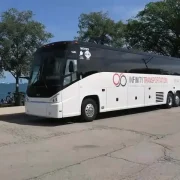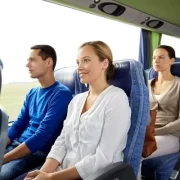Lake Forest’s event calendar keeps expanding, and so do the expectations for smooth, coordinated transportation. If you’re planning a wedding shuttle, a school field trip, or a corporate offsite, the newest charter bus options make it easier to keep people together without sacrificing comfort. Booking tools and vehicle tech have advanced enough that you can skim schedules, compare amenities, and simply tap View Details to confirm the right fit for your group. Whether you’re a local planner or a first-time visitor, a Lake Forest Charter Bus provider can now match specific needs—from ADA-ready coaches to luxury interiors—without guesswork. The sections below explain how features, planning strategies, and safety standards align to make group travel feel seamless in 2025.
Modern Bus Features That Enhance Lake Forest Group Travel
Today’s motorcoaches are engineered to make group trips feel more like a rolling lounge than a rigid shuttle. High-back reclining seats with generous legroom reduce fatigue, while climate control and quiet cabins help conversations and work sessions flow naturally. Reliable Wi‑Fi, power outlets at every seat, and USB ports let teams answer emails, download presentations, or keep kids entertained between stops. Many fleets also include ADA lifts, priority seating, and wide aisles, ensuring accessibility is built in rather than added on. For planners in Lake Forest, choosing a Lake Forest Charter Bus with these features means you can keep productivity and comfort in focus from the first pickup.
Onboard amenities that matter in 2025
Modern coaches pair practical comforts with smart technology that cuts friction. Real-time GPS tracking helps dispatchers and planners see exactly where vehicles are, while onboard PA systems keep groups informed without shouting across rows. Restrooms and ample overhead storage reduce unnecessary stops and cluttered aisles, and tinted panoramic windows bring in natural light without glare. Entertainment systems—think HD screens and Bluetooth audio—offer curated experiences for company retreats, youth teams, and wedding parties alike. Small touches like antimicrobial surfaces and hands-free doors add peace of mind, especially for mixed-age groups.
Drivers and coordinators are also benefiting from upgraded telematics that monitor fuel efficiency, braking patterns, and maintenance indicators. This data quietly enhances ride quality while keeping operations on schedule. If your itinerary includes scenic detours along the lake or photo stops, coaches with responsive suspension and noise-dampening design maintain a relaxed environment. These modern features don’t just add polish; they remove the small discomforts that can derail group focus over a long day. Choosing technology-forward vehicles is an easy win that your riders will notice within minutes.
Planning Corporate and Community Trips With Fewer Logistics
Event planners and office administrators used to juggle a maze of carpooling, reimbursements, and parking passes. In 2025, the smarter approach is a single itinerary synced with your charter provider, complete with designated pickup zones, timed boarding, and an organized drop-off flow. Corporate groups get to meetings without the stress of parking downtown, while community organizations can shepherd attendees to concerts, festivals, or volunteer projects with minimal friction. A Lake Forest Charter Bus partner can also stage multiple vehicle sizes—sprinter-style shuttles for feeder routes and full-size coaches for main legs—so your plan scales gracefully. Coordinators appreciate that one confirmed schedule cuts emails in half and ensures every bus reaches the right door at the right time.
Steps to streamline planning
- Define your headcount range early and select vehicle mixes that match each leg of the trip.
- Map pickup windows to avoid rush-hour choke points and set clear staging zones.
- Share a mobile-friendly route overview and encourage riders to arrive 10 minutes early.
- On booking platforms, skim amenity checklists and tap View Details to confirm accessibility, storage, and tech needs.
- Assign a single point of contact who can receive driver updates and push brief alerts to riders.
Professional dispatch teams help you build realistic timelines, adding buffer for boarding and potential detours. They also offer insights on local traffic patterns, venue loading docks, and city regulations that affect curb use. When everything is centralized—from headcounts to route maps—you minimize last-minute questions and lost attendees. The result is a calmer day-of experience and a more predictable budget, both of which matter to stakeholders and guests alike.
Why Charter Buses Improve Comfort for Long Routes
Longer rides are where charter buses truly differentiate themselves from car caravans and fragmented rideshares. Purpose-built seating distributes pressure across your back and hips, while generous seat pitch and footrests support circulation over hours. Quiet cabins reduce fatigue by cutting vibration and road noise, and zoned climate control ensures the cabin doesn’t swing from chilly to stuffy as the day changes. Onboard restrooms lower stress for families and older travelers, allowing the itinerary to stick to planned stops rather than emergency detours. For groups moving between Lake Forest and regional hubs, these comfort upgrades turn transit time into a pleasant transition, not a hurdle.
Ergonomics and the onboard environment
The ergonomics of modern coaches reflect lessons from aerospace and hospitality: a combination of seat design, cabin acoustics, and airflow matters. Adjustable lighting allows riders to read or rest without disturbing neighbors, while individual air nozzles let everyone set their own micro-climate. The difference is most noticeable after two hours—neck muscles stay relaxed, and riders arrive fresher for tours, meetings, or ceremonies. If you’re transporting event speakers or athletes, the ability to hydrate and move comfortably in transit can meaningfully impact performance. Add in Wi‑Fi and chargers, and the ride becomes productive downtime rather than idle hours.
A few practical tips maximize comfort further. Encourage riders to bring a small daypack rather than bulky luggage, keeping aisles clear for safe movement. Schedule one scenic stretch break on routes exceeding three hours; it keeps energy positive and photo albums full. Share a short pre-trip note on seat rotation for school groups or teams, so interactions feel fair and inclusive. When these human details align with well-designed coaches, your group arrives aligned, not drained.
Reducing Traffic and Emissions Through Group Transportation
Group travel by charter bus lightens the load on local streets while making a measurable dent in per-person emissions. Instead of 20 cars circling for parking, one coach consolidates arrivals and reduces idling around venues and neighborhoods. Fewer vehicles also ease congestion near schools, parks, and retail districts, which helps businesses and pedestrians alike. On a per-passenger basis, modern diesel and alternative-fuel coaches often outperform single-occupancy cars for carbon efficiency, especially on regional routes. The gains multiply for repeat events, turning transportation into a visible part of your sustainability strategy.
Eco gains that add up locally
Lake-adjacent corridors and downtown Lake Forest both feel the benefits when groups ride together. Venue operators spend less time managing crowded lots, and nearby residents see smoother traffic patterns on peak days. Police and event staff can focus on safety and wayfinding, not bottlenecks created by rideshare churn. Organizers who publish their transportation plan in advance—including shuttle frequency and pickup pins—usually see higher adoption and fewer last-minute drive-ins. Over time, riders learn that the coach is the default, not the backup plan, which keeps turnout high and carbon output lower.
Consider specifying eco-forward features in your RFPs. Options like idle-reduction tech, low-emission engines, or even electric shuttles for short circulators are increasingly available in 2025. When paired with full seating utilization, you can reduce total vehicle miles traveled and shrink your event’s footprint without sacrificing convenience. It’s a practical way to align community goals with attendee experience, making sustainability visible and easy to embrace.
Coordinating Multi-Stop Itineraries With Professional Drivers
Multi-stop itineraries introduce complexity—think hotel pickups, photo stops, venue transfers, and late-night returns—but professional drivers handle this choreography daily. They’re trained to stage efficiently, load quickly, and communicate with dispatch when adjustments are needed. Clear manifests and labeled luggage streamline boarding, while curbside coordination keeps the pace steady without feeling rushed. If a speaker runs long or a team game goes to overtime, drivers can work with planners to resequence stops and hold capacity where it’s needed. The result is a flow that feels intuitive to riders, even when the plan evolves in real time.
Tools and best practices
- Build a stop-by-stop timeline with planned dwell times and realistic buffers.
- Share live contact info for the group lead and backup, plus venue dock details.
- Use color-coded wristbands or signage for subgroups boarding different coaches.
- Align meal breaks with venues that can handle bus parking and quick service.
- Provide drivers with a concise route pack: maps, access codes, and special instructions.
Technology complements driver expertise. Digital route boards, text alerts, and GPS sharing keep everyone informed without creating noise. For large events, consider staggered departures with a holding pattern near the venue to prevent curb congestion. Professional drivers will guide you on what’s workable block-by-block, including places where U-turns or extended dwell times aren’t feasible. When you treat the driver-dispatch team as partners, the itinerary stays flexible without losing structure.
Safety Standards That Define 2025 Travel Expectations
Safety expectations have evolved, and reputable providers now showcase them as a central value rather than a footnote. Regular preventative maintenance, stringent driver vetting, and real-time vehicle diagnostics keep coaches road-ready. Many fleets use telematics to monitor speed, braking, and lane stability, turning data into proactive coaching for safer driving. Cleanliness remains a priority, with sanitation protocols that emphasize high-touch surfaces and ventilation cycles. For families, schools, and corporate risk managers, this visible commitment to safety is nonnegotiable in 2025, and a Lake Forest Charter Bus company should be ready to document it.
What to verify before you book
- Active operating authority and satisfactory safety rating with relevant regulators.
- Proof of insurance that meets or exceeds your organization’s requirements.
- Driver credentials: CDL class, medical certifications, background checks, and experience.
- Maintenance logs, including brake, tire, and lift inspections.
- Safety equipment onboard: first-aid kit, fire extinguisher, emergency exits, and ADA lift testing records.
Ask how drivers are trained for local conditions—rain bursts, lake-effect fog, or tight downtown turns—and whether they receive refresher courses. Inquire about incident response protocols, from roadside assistance to passenger communication. Providers that share dashboards or automated safety summaries show they’re comfortable with accountability. If your itinerary includes nighttime returns, confirm policies on rest periods and dual-driver rotations for longer runs. These details protect both passengers and schedules, reinforcing that safety and reliability go hand in hand.
How Reliable Transport Strengthens Group Coordination
Reliable transport doesn’t just move people; it aligns schedules, reduces stress, and preserves energy for what matters at the destination. When your coach arrives and departs on time, attendees can plan their day confidently, presenters stay on track, and volunteers focus on guests instead of rearranging rides. Clear pre-trip communication—pickup windows, bag policies, and emergency contacts—keeps boarding brisk and minimizes confusion. For weddings and community festivals, that predictability ensures photographers, caterers, and performers hit their marks. Over the course of a season, these small efficiencies translate into smoother events and happier attendees.
Operational habits that keep groups in sync
- Share a simple itinerary with scannable times, maps, and a dispatcher contact line.
- Use a consistent naming convention for buses and stops (A, B, C) to reduce misboarding.
- Set a five-minute “last call” procedure with a designated headcount lead.
- Create a quick-reaction plan for delays: a secondary pickup point and communication script.
- Close the loop post-event with feedback to fine-tune the next schedule.
Consistency builds trust. When riders see that the plan holds, they engage more fully in the program—networking at a conference, celebrating at a wedding, or cheering at a game—because the next step feels certain. If you’re evaluating providers, scan amenity lists and operational notes, then tap View Details to confirm dispatch support, GPS tracking, and contingency policies. These are the quiet pillars of coordination that make a busy day feel effortless. In 2025, a dependable charter partner is more than a vehicle; it’s a system that keeps your group moving as one.













Comments